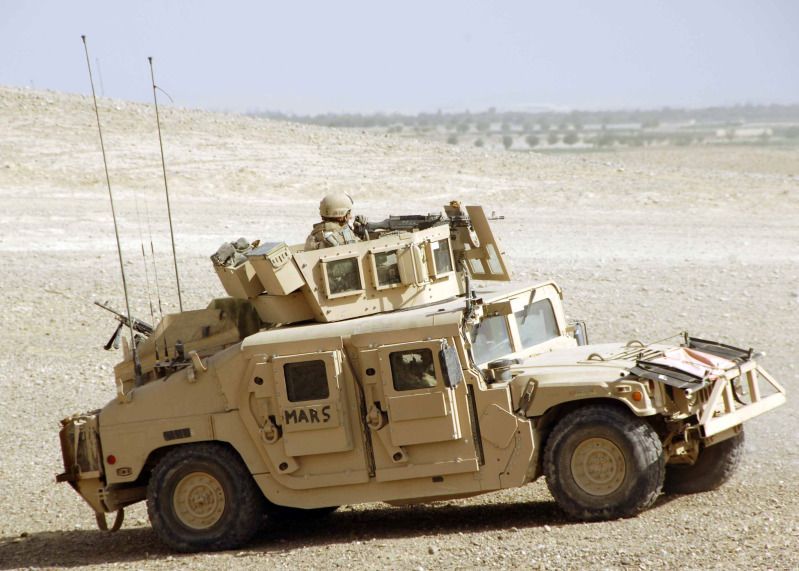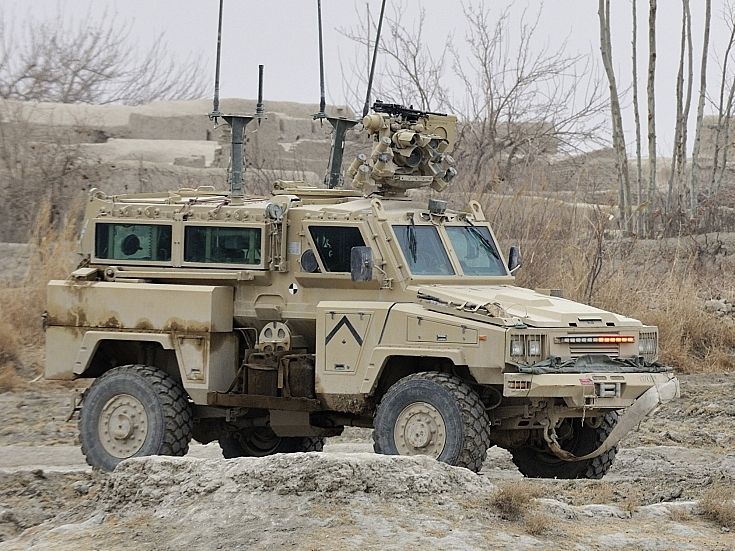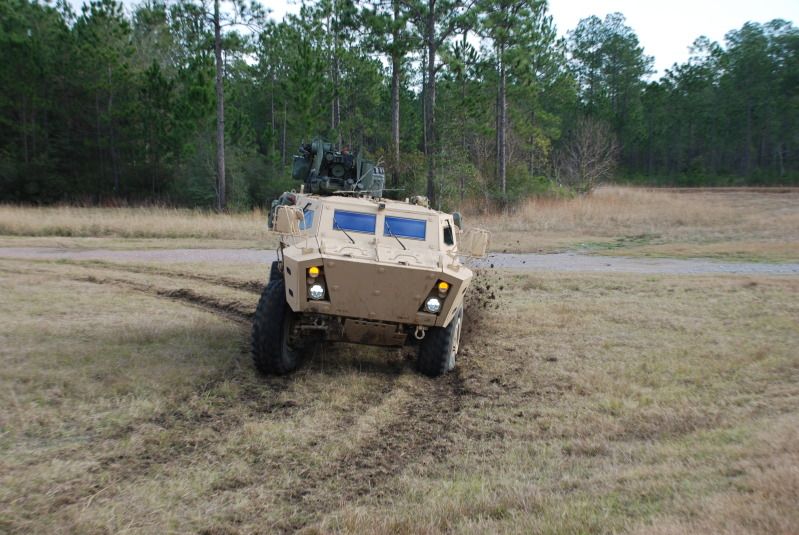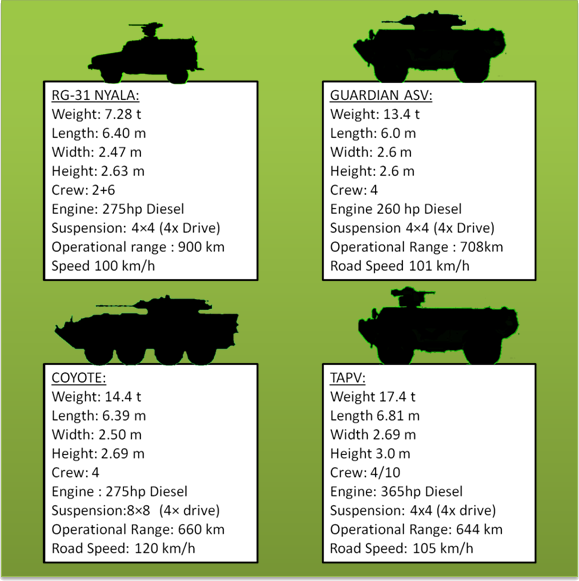TAPV- The Future
of Canada's Reconnaissance Procurement
The US Army, Marine Corps and Special Operations Command
have been using a variety of vehicles in the reconnaissance role. Armoured reconnaissance is conducted using tracked
M3A1 Bradley IFVs or wheeled LAV-25's.
Infantry reconnaissance is conducted with the lightly armoured HMMWV, or
the wheeled Stryker RV (incidentally built on the LAVIII chassis manufactured by
Canada's General Dynamics Land Systems).
In 2008 the American DOD (Department of Defence) initiated the second
phase of a procurement contest seeking a replacement for its aging HMMWV fleet
with an emphasis on reconnaissance/communication capabilities.
Bogged
down by complex requirements, politics and contract lobbying, the JLTV program
has yet to produce a tangible replacement meeting all the needs of the US Army,
USMC and USSOCOM. Canada in the meantime
has forged ahead with design, testing and procurement. Canada bought 75 of the RG-31 Nyala an MRAP
produced in South Africa. While robust
and versatile, the Nyala suffers from low survivability in IED attacks and are
more expensive to maintain than an indigenous vehicle.
The TAPV is developed by Textron Systems Canada a subsidiary of the American company Textron. An office in Ottawa, Ontario is responsible for overseeing the project to completion. The preliminary order (due at the latest in 2016) is for 500 vehicles, 200 in reconnaissance pattern and 300 equipped for infantry transport. Though the design is sourced internationally, as are specific components the vehicles will be produced in Canada at Textron's fabrication plants.
Textron Systems President and Chief Executive Officer Fred Strader was quoted on the company's website as saying: “ “We are honoured that the Department of National Defence and Public Works and Government Services found our team and vehicle best suited to their needs for this important program... ...The Textron TAPV will provide the men and women of the Canadian Army a fully supportable tactical armoured vehicle platform that delivers outstanding performance in the world’s most challenging environments.”
In World War II shortly after the Battle of Normandy,
Canadian light-infantry units coming from Juno Beach and pushing into
Holland/Belgium engaged and destroyed elite mechanized units of Hitler's elite
Waffen SS. This storied feat was
accomplished with a mixture of superior information sharing, logistics,
communication, infantry doctrine and superior period anti-armour
equipment. Since that time, Logistics,
Light infantry, RSTA (Reconnaissance, Signals, Target Acquisition) units and
RSTA technologies have become the mainstay of Canada's contribution to many
international efforts ranging from the Koreas to Afghanistan. Canada has in many cases sent small observer
forces, logistical support or peacekeeping missions where a low profile and
effectiveness buoyed by information analysis is always necessary. Advances in reconnaissance doctrine and
technology have made Canada's ability to detect, identify and observe the enemy
almost unparalleled on (or under) land, sea and air.
Currently the RV (reconnaissance vehicle) used by the Canadian Forces is the Coyote. The Coyote RV features a troop-transport cabin that can move a reconnaissance or C4 (Command, Control, Communications, Computers) team. While strong overall as a tactical platform, the Coyote suffers from key weaknesses: First and foremost is the age of the vehicle. At 15 tonnes and built on the ubiquitous 8x8 MOWAG PIRANHA chassis of the LAV-25 used by the USMC (United States Marine Corps) as an IFV (Infantry Fighting Vehicle) the Coyote is heavy and difficult to transport. The large turret is challenging to remove/replace quickly when moved by C-130 Hercules. The Coyote is wheeled making it a good choice for OOTW (Operations Other Than War) particularly where preservation of local infrastructure for peacemaking or nation building is desirable.
Currently the RV (reconnaissance vehicle) used by the Canadian Forces is the Coyote. The Coyote RV features a troop-transport cabin that can move a reconnaissance or C4 (Command, Control, Communications, Computers) team. While strong overall as a tactical platform, the Coyote suffers from key weaknesses: First and foremost is the age of the vehicle. At 15 tonnes and built on the ubiquitous 8x8 MOWAG PIRANHA chassis of the LAV-25 used by the USMC (United States Marine Corps) as an IFV (Infantry Fighting Vehicle) the Coyote is heavy and difficult to transport. The large turret is challenging to remove/replace quickly when moved by C-130 Hercules. The Coyote is wheeled making it a good choice for OOTW (Operations Other Than War) particularly where preservation of local infrastructure for peacemaking or nation building is desirable.
Because of the age of the vehicle, the light armoring on its
chassis requires constant field-upgrading. There were serious high-level
discussions within the DND about replacing the platform. When exposed to roadside bombs, improvised
munitions and landmines (which inflicted the proportionally highest rate of
casualties during the Afghanistan mission) the Coyote did not prove itself and
underscored the importance of a new reconnaissance vehicle with
casualty-prevention features as well as tactical versatility.
 |
| HMMWV in Iraq |
The JLTV (Joint Light Tactical Vehicle) program was
commissioned to find a suitable replacement to the HMMWV. As a stopgap measure, the HMMWV and in many
cases-- heavier combat vehicles were replaced with the MRAP (Mine Resistant
Ambush Protected) vehicle of which there are numerous competing models, making
standardization of doctrine or equipment between joint or international forces
particularly difficult.
 |
| RG-31 Nyala in Afghanistan |
Enter the TAPV. On June 8, 2012 the Department of National
Defence announced a winner in its performance trials for a Coyote
successor. The Textron TAPV (Tactical
Armoured Patrol Vehicle) was hands down a winner. An almost $1bn contract was established by
the DND to ensure procurement and delivery of these vehicles by 2014.The TAPV
incorporates numerous new features into its design.
Coming back to design and history, the vehicle is significant because it
is based on a German design. Our light
combat car is the Mercedes G-Wagen, produced initially for the Bundeswehr. Our main battle tank is a semi-indigenous
adaptation of the German Leopard 2A4 with a few top-tier Leopard 2A6M tanks on
loan from the Netherlands. Even the
vehicle's name is a triumph of marketing.
TAPV is pronounced as 'TAP-VEE'.
A light-armoured vehicle in use as troop-transport and reconnaissance
platform by the Bundeswehr is the TPz Fuchs, commonly referred to as a
'TAP-ZEE' which shares a similar profile and role to the TAPV. Given the integration of German-developed
weapons systems into the Canadian Forces it is safe to say that the similar vehicle
nicknames are probably not coincidental.
The TAPV is developed by Textron Systems Canada a subsidiary of the American company Textron. An office in Ottawa, Ontario is responsible for overseeing the project to completion. The preliminary order (due at the latest in 2016) is for 500 vehicles, 200 in reconnaissance pattern and 300 equipped for infantry transport. Though the design is sourced internationally, as are specific components the vehicles will be produced in Canada at Textron's fabrication plants.
TAPV manufacturer Textron Systems
Canada currently employs 2,200 Canadians in manufacturing at its plants which
also produce the Cessna model small airplane.
Textron Systems President and Chief Executive Officer Fred Strader was quoted on the company's website as saying: “ “We are honoured that the Department of National Defence and Public Works and Government Services found our team and vehicle best suited to their needs for this important program... ...The Textron TAPV will provide the men and women of the Canadian Army a fully supportable tactical armoured vehicle platform that delivers outstanding performance in the world’s most challenging environments.”
Meanwhile a quote taken from the DND website regarding the
TAPV says: "TAPV is a component of the Land Forces Combat Vehicle program
which is focused on the renewal of the Army's core equipment platforms as
stated in the Canada First Defence Strategy. The TAPV project will deliver a
wheeled combat vehicle that will fulfill a wide variety of roles domestically
and on the battlefield, including but not limited to reconnaissance and
surveillance, security, command and control, cargo, and armoured personnel
carrier. It will have a high degree of tactical mobility and provide a very
high degree of survivability to its crew."
As an indigenous weapons system, the TAPV offers
independence to Canadian interests around the world in that we are not reliant
on overseas import (as in the case of the RG-31 and the G-Wagen) for parts or
technical support. As a high-tech
vehicle, the TAPV is capable of supporting the advanced satellite
communications, optical surveillance and C4 equipment necessary to fight a
fourth or fifth generation conflict.
High survivability, excellent tactical mobility, variety of standardized
weapon options for the integrated CROWS (Crew Remote Operated Weapon
System).
The design has already been
battle proven. To be precise, the TAPV is a Canadian-built version of the M1117 Guardian Armored Security Vehicle which
was adopted by US Army Military Police for force protection/convoy/escort
duty. The Canadian designed TAPV and the
current ASV differ in several ways. The
ASV has a one-man turret mounted on the hull while the TAPV's gunner is internal
and the weapon system controlled remotely via an electronic interface. The ASV is also configured to carry a maximum
of four personnel while the TAPV has two variants, a reconnaissance variant
carrying four and a transport variant carrying 10 (3 crew + 7 passengers).
In his book, "A Soldier First" General(ret.) Rick
Hillier (former CDS and Operational Commander for Canadian Forces in
Afghanistan talks about the dangers of adapting foreign-built weapons systems
for use in Canada. In particular he relates an anecdote about a tank-gunnery
competition in Germany where insulated wiring (intended to protect delicate
instruments from harsh Canadian winters) were overheated due to a design flaw
by the hot German sun. This in turn
threw off the accuracy of the tank's main gun leading to the disqualification
of the Canadian team. Hillier cautions
against the 'Canadianization' of platforms and espouses either indigenous
development or 'as-is' purchase from foreign suppliers, ideally supported by a
maintenance contract.
In terms of cost, at $500m(CAD) for 500 vehicles and a
further $180m(CAD) for ongoing support the TAPV is an excellent choice. The procurement will stimulate the Canadian
economy while also improving Canada's ability to contribute internationally. This in turn should raise our standing in
terms of our international obligations.
Improved international standing of course has its own hidden economic
benefits. Whether or not this will
improve Canada's ability to contribute to the UN and improve our standing to
the point of regaining a seat as a security-council member, remains to be seen. Overall this is a good example of the ongoing
're-modernization' of the post-Afghan War Canadian Forces in order to build a
stronger, safer society.
Now some critical questions for those of you with experience in these
matters:
1) The ASV-M117 currently in use by American military police is not NBC
rated. Is the Canadian variant going to
be fitted with NBC protection?
2) How does the four wheeler design stack up in terms of
mobility, stability and reliability against the TpZ Fuchs' six wheels or the
LAV III's eight?
3) How will the
side-door access change existing Canadian Forces doctrine for a TIC debus? Is there an internal ramp to ease the exit
with full combat load or are the awkward videos of soldiers getting in and out
of the half-gull doors pretty much par for the course as to what our personnel
can expect?












